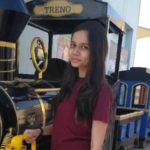eCommerce Shipping Best Practices for Indian Sellers in 2024
You’re probably putting a lot of effort into listing your products, finding the right suppliers, uploading product images, writing emails, doing it all to make your customers happy.
But until you’re paying attention to the aspect of shipping and fulfillment for your business, all your efforts might be in vain, without you even knowing about it.
In today’s progressive world, where the eCommerce industry is growing at an unprecedented rate, shipping is the ultimate point of convergence for customer satisfaction and an improved eCommerce experience.

If done the right way, shipping can help you sell products like hot cakes in the market. And we’re here to prepare you for it. Read on to find out the best practices to swear by in 2024 and excel with eCommerce shipping like a pro:
What should you look at? (Shipping considerations)
When we talk about customer satisfaction, the entire eCommerce experience comes down to one single element- shipping and product delivery. Consider it as something that can make or break your business. Most of the sellers strive hard to improve their shipping strategy, but seldom figure out where to start.
Shipping is also that stage of your order fulfillment process where you might feel that you no longer have complete control over your brand. However, if you’re looking at the right parameters, you may have more to do with shipping than you think.
One of the factors that sellers are inclined towards is shipping costs. Shipping costs can make a tremendous difference to your business, which is why one must plan a nuanced strategy around it.
While high shipping costs can make you lose customers, very low shipping costs can do the same for the profit margins of your business.
Getting this piece right can open your doors to unrivaled profits and customer satisfaction. However, having full control of your business will not just mean offering the lowest rates, but also the shipping options that your customers are expecting.
As a seller, your goal must be to accomplish all and be able to cover your costs at the same time. Let’s have a look at the most common considerations you’re probably missing out on, which can have a direct impact on your shipping:
Size and Weight of your Products
No matter what your approach is, the size and weight of your products are something you can directly exercise your control on. It also has a significant impact on your overall shipping strategy. Understanding the size and weight of your products can help you adopt a pricing strategy for your shipping.
For example, if a majority of your products have similar size and weight, you can go for per-item shipping rates based on zones that vary depending upon the location of your customer, rather than weights. This practice can help you find flat rates for shipping your parcels to your customers.
Alternatively, you can break down your products into groups of specific weights and dimensions to get a clear picture of what you’re shipping and how much of the costs are dependent on weights.
While this practice can help you strategize on saving your shipping costs, it can also lead to a better return on investments.
Tip: When you carry on this process, make sure you take the accurate weight and dimensions of your product so that you are also able to estimate the adequate packaging required for your products.
The Shipping Destinations
Looking at shipping destinations is another critical consideration for eCommerce sellers. Since most of your customers are expecting free shipping, it is best to offer a flat rate shipping based on the zones that you’re shipping to. Not only will it cost you less, but it also puts less burden of shipping costs on your customers.
Tip: If you’re shipping to Delhi, charge a flat rate to your customers and radiate your costs as the destination varies within Delhi and moves to different states.
The Choice of a Shipping Partner
To avoid feeling like you have no control over your business once you hand over the parcel to the courier company, it is best if you choose a smart shipping solution that instead allows you to be in check of your package.
If you’re looking at the big carriers, the best thing you can do for your business is to look at other options for shipping your products that have tons of features designed to help your business grow.
Look beyond just shipping and try to find a solution that helps you fulfill your orders in the most efficient manner possible. Your solution must not only provide you competitive rates, but it must also give you additional advantages like order tracking, undelivered report, and return management, etc. It must give your entire logistics supply chain a boost, rather than just one aspect of pickup and delivery.
Tip: Analyze the significant concerns of your business around managing inventory and shipping. Then, go for a courier aggregator such as Shiprocket which can help you understand your shipping analytics and provide features to simplify your order fulfillment process.
Warehousing & Inventory Management
According to a report, 34 percent of businesses have shipped an order late because they inadvertently sold a product that was not in stock.
These delays are common if your warehousing and inventory management are not in order. For your shipping to be top-notch, it is important that you optimise warehousing and inventory management to match your requirements. If the backend of your logistics is not strong, delays and poor performance cannot be eliminated.
Inventory management is a process that cannot be ignored. If you run a small business, sell from home, or receive more than a hundred orders a day, the drill remains the same. If your inventory isn’t synchronised, you will face shipping delays and your customers will not have a seamless experience with your brand.
A great shipping consideration would be having in place an inventory management system so that you can keep a continuous track of your inventory, forecast future sales, and plan accordingly for every aspect of your business.
Read more about the inventory management software you can utilize for your business.
Warehousing plays a critical role in your order fulfillment chain as your entire inventory is housed in a warehouse and that is where the heavy lifting work of picking, packing, and shipping actually takes place. That makes it extremely important for the place to be organised so that all the actions can be performed in an organised manner.
Tips to Optimize Warehouse Management
- Store everything in bins and racks
- Properly label every section of the warehouse
- Add barcodes for easier tracking and location of products
- Use a warehouse management system to track inventory
- Use automated picking machines to avoid wastage of time in the warehouse
- Follow proper SOPs for all processes
Since your products are shipped actively from the warehouse, it must be close to your buyer’s destination so that you can ship faster. This is one shipping consideration that you cannot ignore.
Increasing your delivery speed is a common requirement of almost every seller. So how can you give your business the edge? Outsourcing these operations.
Yes, you can share your inventory with a third party fulfillment company like Shiprocket Fulfillment and house your products in their warehouses. This way, you will be able to manage your business better and also deliver faster to your customers.
Outsourcing warehousing and inventory operations to a third-party can be beneficial in several ways.
- You get access to warehouses across the country, which helps you store products closer to your buyers.
- Since the team specialises in these operations, they are experienced and know the drill when it comes to efficiently picking, packing, and shipping the product.
- As the product gets delivered on time, you can also reduce undelivered orders that ultimately lead to RTO.
Seamless product management will pave way for hassle-free shipping that in turn will lead to timely delivery of orders.
Hence, don’t forget this important shipping consideration when you plan your order fulfillment operations.
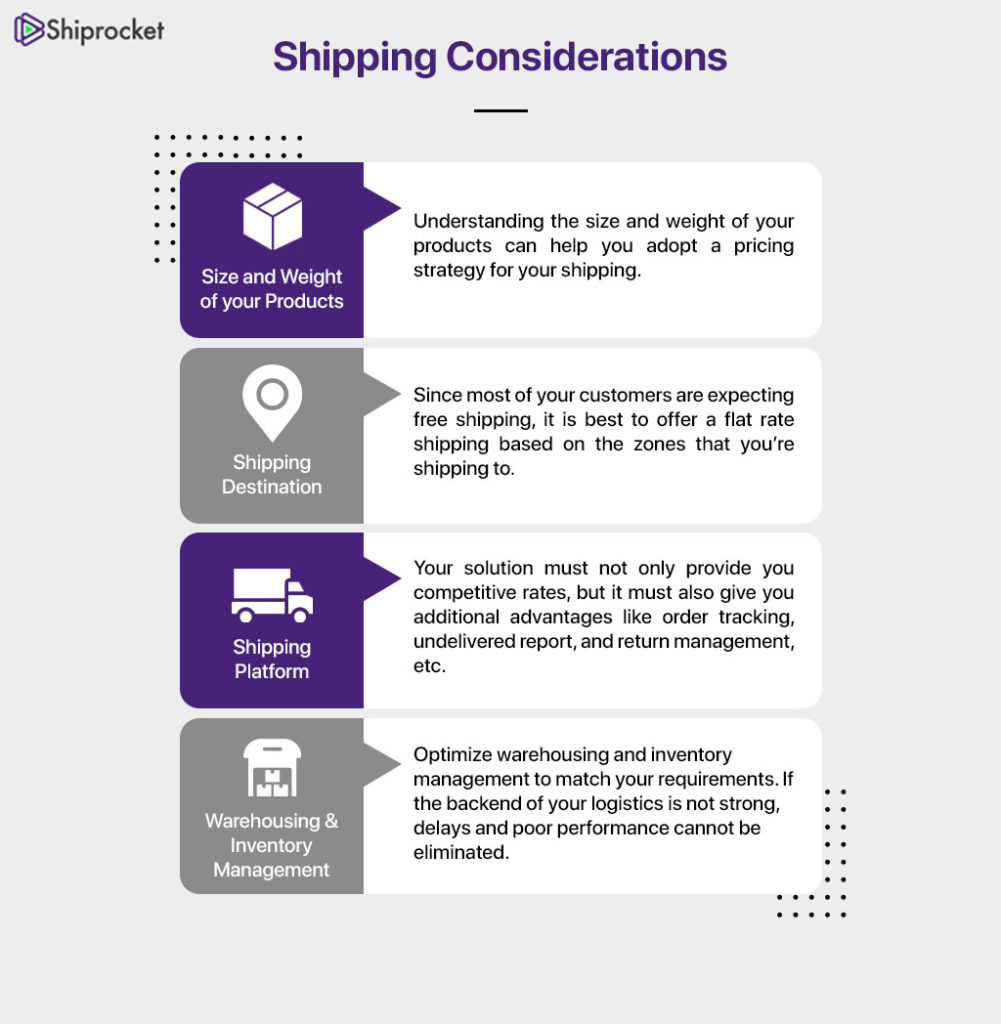
eCommerce shipping process
Whether you’re starting your business from scratch, or running it successfully across multiple channels, your eCommerce shipping process must be straight. You’ll need to spend some time analyzing your shipping policy (or creating ii you still don’t have one), setting your shipping goals so that you realize the key areas where you have to work hard, and lastly choosing a shipping software for a smoother last mile order fulfillment process
Let’s have a look at each of these closely –
Shipping Policy
How do you plan to address your customer queries related to shipping, without something to stick to? Exactly! That’s what you need a shipping policy for!
Especially, when you own a website, publish your shipping policy page at an easy to reach section so that customers can refer to it before making a purchase.
Even market research has this backing up! 80% of the customers would prefer referring to your shipping policy for information on shipping costs, delivery timeframes, returns, etc.
So, as you begin to draft your policy, make sure you have the following points covered-
Shipping Rates
Mention whether you’re offering flat-rate shipping, free shipping, or threshold-based free shipping. It puts a clear picture of your business in front of the customer
Tip: If your shipping costs vary based on your customer’s purchase, it is wise to add a shipping rate calculator at the checkout.
Delivery SLAs
Do you offer same-day delivery for your products? Mention it in your shipping policy page. Providing the information on how long you take to deliver your customer’s packages, is definitely something that will help them in proceeding with purchase from your store. This way they’ll know when to expect the product at their doorstep.
Shipping Carriers
Customers want to know the couriers you use to ship products so that they know where to expect tracking messages in their inbox. Also, it gives them a sense of trust if they have heard of the courier partner before. Even though this is not completely necessary, you can choose to show it in your policy to boost confidence among customers
International Shipping Guidelines
Be sure to divulge this information, if you offer international shipping to entice any potential customers.
Delivery Exceptions
Delivery exceptions must be highlighted in your policy pages to establish transparency. For example, if you don’t ship to specific areas, mention it in the policy.
Further Reads: A Seller’s Guide to Creating An Ultimate E-commerce Shipping Policy
Shipping goals
I’m sure you have goals in life, it’s time you had a few for your shipping strategy too. Once you’re all set with your shipping policy, the next thing you need to focus on is establishing your shipping goals.
Shipping goals define what you want to accomplish with your eCommerce shipping strategy. Though goals may vary depending on the type of business you’re running, there are a few that reside in the core of your strategy if you’re shipping physical products.
- Heighten Conversions
- Increase Average Order value
- Decrease Costs
- Increase Operational Efficiency
- Expand your reach
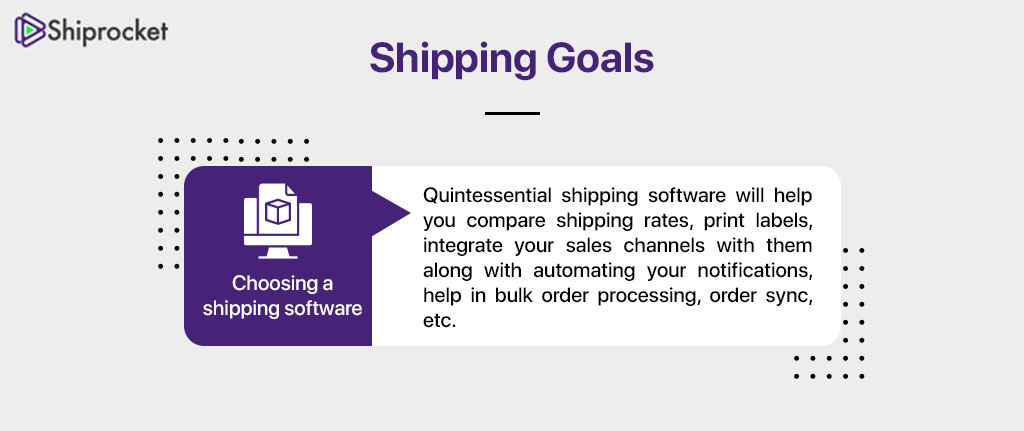
Choosing a shipping software
In the age of automation, doing repetitive tasks is the most outdated habit you’re guilty of pursuing. You’re probably wasting your time and resources on things that a lot of tools and software can do at much lower costs.
And this is why you must choose your shipping software to simplify your tasks and add value to your business. A Quintessential shipping software will help you compare shipping rates, print labels, integrate your sales channels with them along with automating your notifications and doing plenty of other things for your business that you’re deprived of.
But in the process of choosing a good shipping software, here are the fundamental things you must look at:
- Bulk Order processing:
- Email/SMS tracking
- Integration with your sales platform
- Inventory management
- Easier processing of undelivered orders
- Analytics for shipment monitoring etc.
- Return Order Management
- Shipping Insurance
Post shipping order experience is one thing that most sellers neglect, but those who pay attention capitalize on a lot of opportunities.
Tip: Remember that nothing beats customer experience and if your shipping solution can go that extra mile in providing you with that, hop into it. Shiprocket is one platform that can help you market your products well and provide a quality post ship experience to your customers.
Best Shipping Options
Now that you have considered the right parameters for your shipping strategy, it’s time to explore the best shipping options that you can offer to your customers.
Standard Shipping
Standard shipping is the regular shipping option that you give your customers by default. This means that the product will be shipped in 3 to 5 days and delivered in about 7 to 10 days maximum. There is usually no cap you can provide to the number of days as it varies from carrier to carrier and it’s shipping in every zone.
For example, if you are shipping from Delhi to a metropolitan state, sometimes standard shipping can also be done in a day or two. But if you are shipping to the north-east, Jammu & Kashmir, or Tamil Nadu, the delivery time might be higher.
Standard shipping is usually done by other means of Road transport. The products are loaded onto a truck and then taken from the courier hub to the nearest delivery hub. Hence, standard shipping takes more time. If you have a low shipping budget and are looking for cheap shipping options, you can offer just standard shipping to your buyers.
Even though it takes time, if you market your product properly, it will be worth the wait for the customer.
Express Shipping
As the name suggests, express shipping refers to the shipping of products within the same-day or next-day. If you’re looking to offer next-day or two-day delivery, express shipping is your technique.
Amazon has glamorised the idea of next day delivery and today it has become the benchmark to receive products quickly. To achieve this expectation, you need to invest greater in your shipping.
Express shipping is done by means of air transport and packages are loaded into airplanes and transported to the delivery hub from the courier hub.
Of course, you cannot ship everything with express shipping. There are certain restrictions that you need to keep in mind before opting for express shipping. If you can afford it for your business, express shipping can help you provide a delightful delivery experience to your buyer.
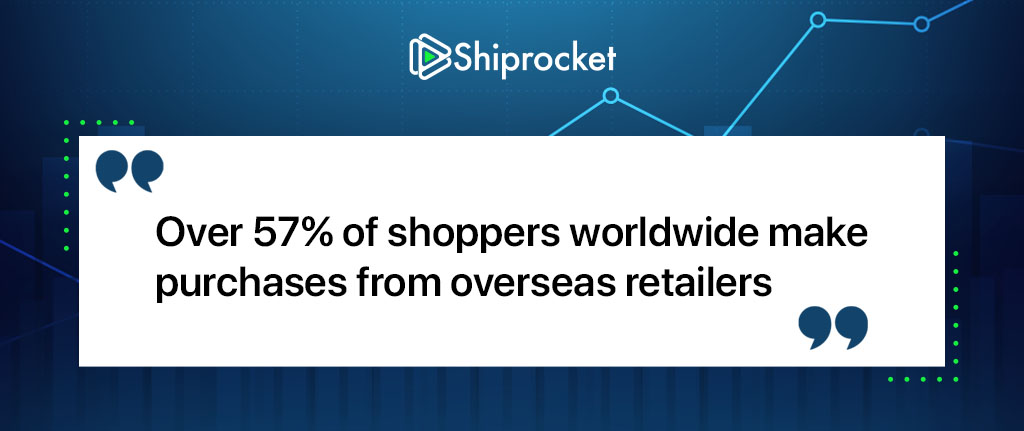
International Shipping
According to statistics, there are around 4.57 billion internet users across the world. Most of them actively shop online. Over 57% of shoppers worldwide make purchases from overseas retailers. This means that there is huge scope in international shipping, and you must align your strategy to make the most of this international audience.
International shipping is not an option for your business if you have clients ordering products from across borders. If your international shipping is not on point, the entire eCommerce experience for your client will be ruined. Ensure that you follow best practices like packaging the product properly, label it with the correct details and then ship it to your international audience.
Along with this, make sure your paperwork like the customs documentation, taxes, etc. are in place so that you do not face any delays when you ship your product. On-time delivery is as important when selling your product internationally.
Hyperlocal Delivery
If you want to deliver in a small geographical area, going with standard or express shipping might not be the best option.
Today, individuals have very high expectations from e-commerce. They expect the packages to be delivered the same day if the shop or store is close by. Therefore, to cater to this audience, you must have an alternative shipping technique in hand. Hyperlocal delivery is one technique that can give you access to same-day delivery for delivery within a few hours directly to the customers.
Hyperlocal delivery refers to the process of delivering products to customers within a short distance at reduced times. With hyperlocal shipping, you can deliver products like food, grocery, medicines, clothes, personal care items, etc.
As soon as you place a hyperlocal order, a rider is assigned to you. The rider will come and pick up the products from your store and deliver it. All you need to do is handover your product along with the invoice.
The main benefits of hyperlocal delivery include the absence of stringent packaging guidelines and no volumetric weight is taken into consideration. You just need to pack the product appropriately so that it does not have any leakage, spills, or damage on the way. Also, you reduce the first mile and last-mile delivery hassles by delivering the product directly to the customers’ doorstep.
Hyperlocal delivery is the most viable option for your business if you want to deliver within the city. You can download the Saral app if you want to deliver within a distance of 50 km with multiple delivery partners like Dunzo, Wefast, Shadowfax. The rates start at Rs.39 so it is not even heavy on the pocket.
Post the lockdown, the purchase dynamics of users have changed drastically. People are now interested in getting products delivered at their house and not go to shops to practice social distancing. With hyperlocal deliveries, you can easily target this segment of customers and create a loyal customer base for your daily use products.
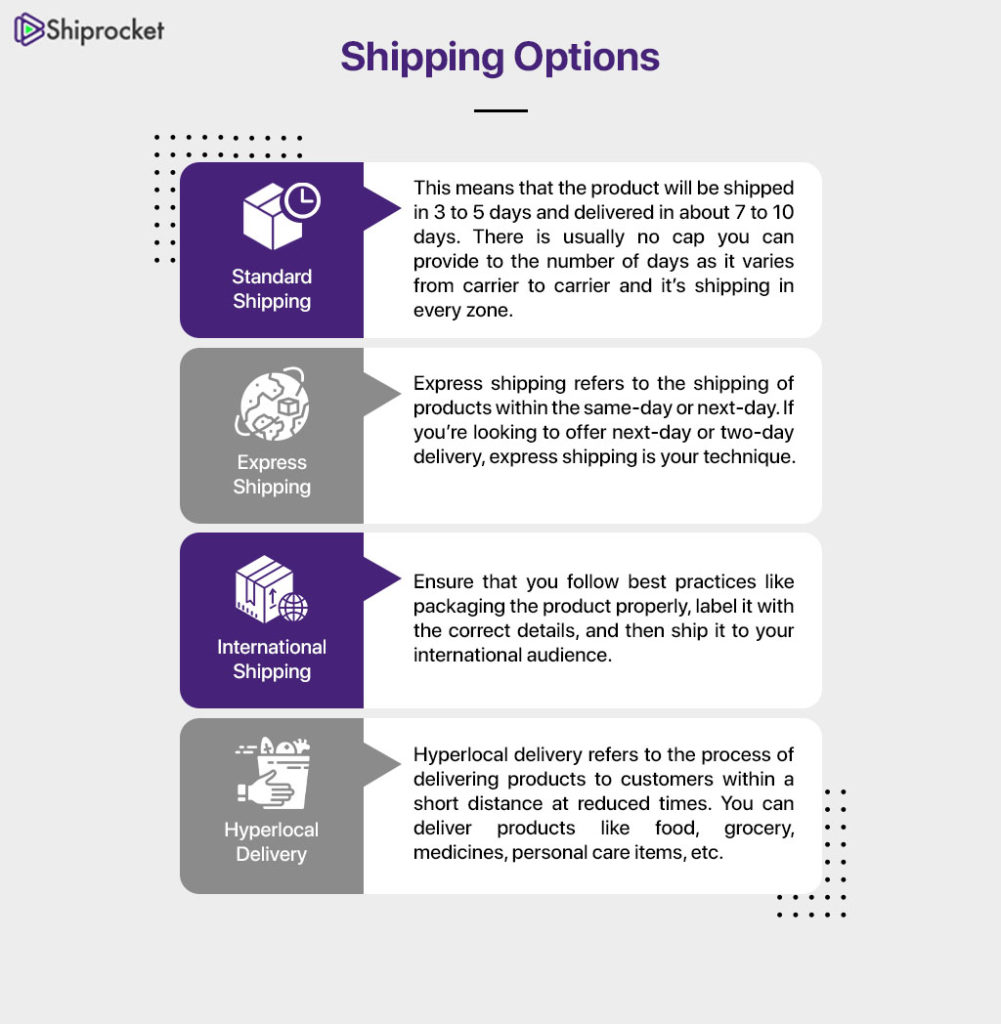
Deciding Upon Shipping Costs?
Free Shipping
Whether you’re selling products or not, free shipping is a term you couldn’t have missed. But as popular as it is, free shipping is equally challenging for a seller.
Popularised by eCommerce giant Amazon, free shipping has now raised customer’s expectations, forcing it for adoption to all eCommerce sellers, whether big or small.
If you’re still in qualms of its benefits, here are a few-
- Easy for customer’s understanding
- It appeals to the customer
- People are more drawn towards completing checkout with free shipping
Free shipping is the best thing you can do for your customers, but it might be an overload for your business.
So, if you’re offering it to your buyers, make sure you have something as a backup for your business. Here’s what you can do-
- Add a threshold order value for free shipping. All the big guys are doing it. You should too! Whether you look at Amazon, Flipkart, Myntra or other brands, they are all ready to offer free shipping, only if you shop for a certain minimum value. And guess what? Customers do.
- Offer seasonal free shipping: If you offer once in a while free shipping to your customers, it will create a rush to shop more, ultimately balancing your shipping costs by increased sales.
Tip: Set the order threshold value for free shipping at least 15-20 times your average order value to accommodate your free shipping costs.
Flat-rate shipping
Free shipping might be the best option, but if you’re not willing to offer it, the next best thing you can do is offer flat rate shipping.
Ever been to a shopping site that offers one shipping cost, no matter what your order value is? Yes, that’s flat rate shipping. You charge a flat rate across a zone and standardize costs. Therefore, when a customer visits your store and puts in their pin code, they will only see one standard shipping cost.
Tip: So, if you’re offering a flat rate shipping you can charge, say, Rs 50 for most of the zones in India.
Live rates
Another shipping option that can cover your costs and provide affordable shipping options is offering live rates to your customer. Live rates from a carrier send a clear message to your customers, on what and why of your shipping costs.
Though, it is definitely not one of the options you can promote for your business because the costs will rapidly vary with the destination of the package and its weight.
Tip: Partner with multiple couriers and offer a chart of shipping costs to the customers as live rates. Your customer will be tempted to compare and select the cheapest option. Alternatively, negotiate with your courier partners to offer cheaper shipping for shorter destinations.
Mixed strategies
Swearing by the three options is not the only choice you can make for your shipping strategy. As an eCommerce business owner, you can mix different strategies and look at what works best for your business.
The mixing and matching of shipping options can be extremely effective as it will also allow you to balance your revenue and promotional opportunities at the same time.Tip: You can offer free standard shipping on your products along with levying charges on expedited shipping. Alternatively, if you own a retail store, you can offer standard shipping, overnight shipping along with in-store pick up of your products.
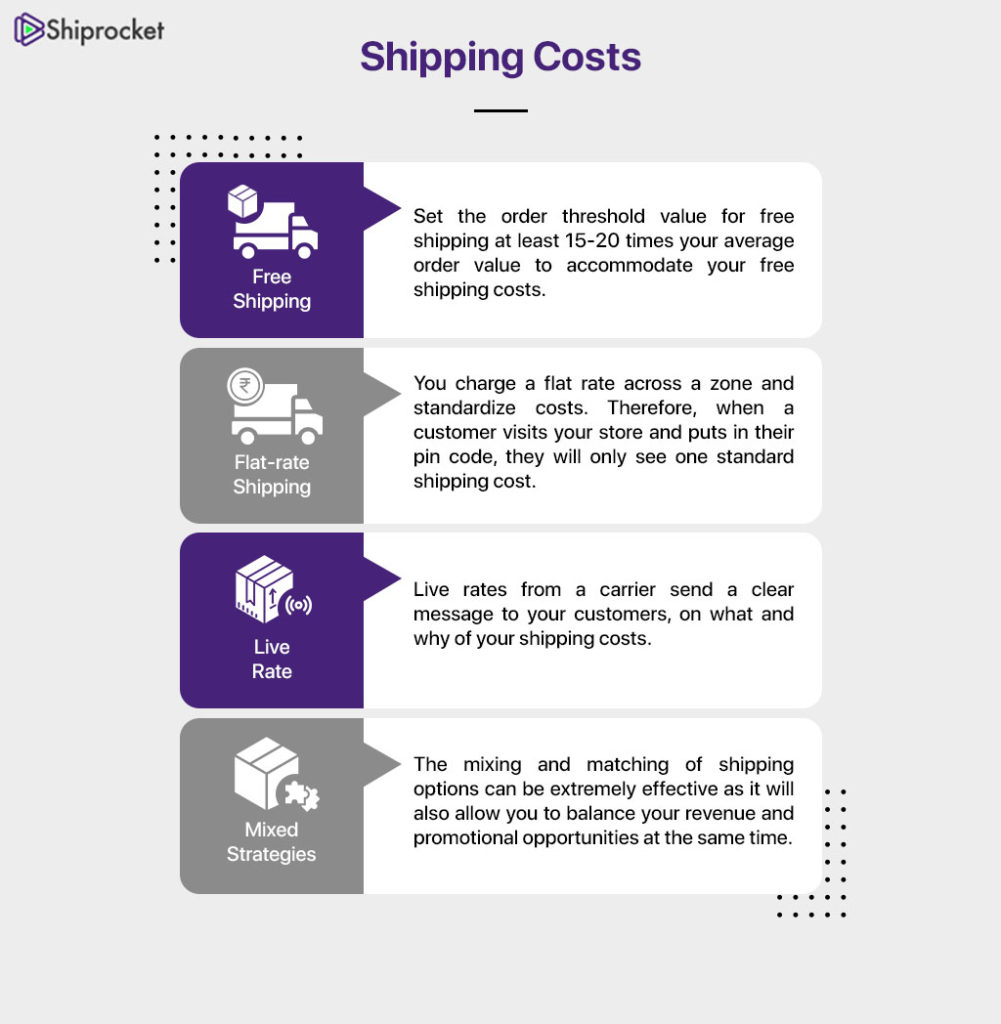
Packaging and Marketing
Getting perplexed while choosing which shipping option to offer to your customers is normal if you’ve never thought of it before. Remember that when you’re starting just provide multiple options to your customers so that they find what they’re looking for.
Once your shipping options are straight, the next element of the fulfillment process that you must focus on is the packaging and marketing. Whether you realize it or not, your packaging plays a huge role in determining your shipping costs.
As the eCommerce industry grows more and more with each passing day, packaging and shipping have moved from being the mere tools of order fulfillment to one of the biggest factors responsible for customer satisfaction.
Your packaging can be a huge selling factor for your brand. And if you go by the saying, the first impression is the last impression, you’ve got one more reason to pay attention to your product’s packaging.
However, if you’ve been neglecting it, it might be one of the reasons for your inflated shipping costs.
Choosing your packaging materials
Choosing the right packaging materials is the first thing you need to take care of, prior to shipping your physical products. Begin by measuring the exact product dimensions and weight, so that you know how much packaging will be required to safely pack your order. Here’s what you can do-
Because most of the courier companies charge you based on the volumetric dimensions, make sure your packaging is sufficient enough to keep your product safe, but not over the top. Put differently, do not package a small product in an excessively large box, or you will be charged for the dimensions of your box.
Hence, if you’re planning to save shipping costs, this is what you must swear by. It’s called utility packaging and your only focus on safeguarding your product.
However, if you’re aiming at creating an impact with your customers, branded packaging is worth investing your time and money. Wrap your product in a craft paper or add a small note for your customer, you can use all your creativity to your packaging.
Follow a Uniform Packaging Process
For your fulfillment process to be in order it is essential that the packaging and shipping align with each other. Since packaging is an important aspect for your final shipping costs, you should have a standard process around it so that you do not have to face weight penalties time and again.
Therefore, you must finalise your packaging material for all your products in advance. For example, if you plan on using flyers, boxes, cardboard boxes, or envelopes, you must do a thorough check of your inventory and finalise the material.
Another important practice would be mapping your SKUs to specific packaging materials so that you can maintain a balance between packaging and product inventory. This will keep you updated on both fronts and you can order more packaging material when you know it’s time.
Along with this, a uniform process and mapping SKUs with packaging will help you reduce weight discrepancies that arise due to improper packaging. Since the dimensions will be standard, this problem will be reduced greatly.
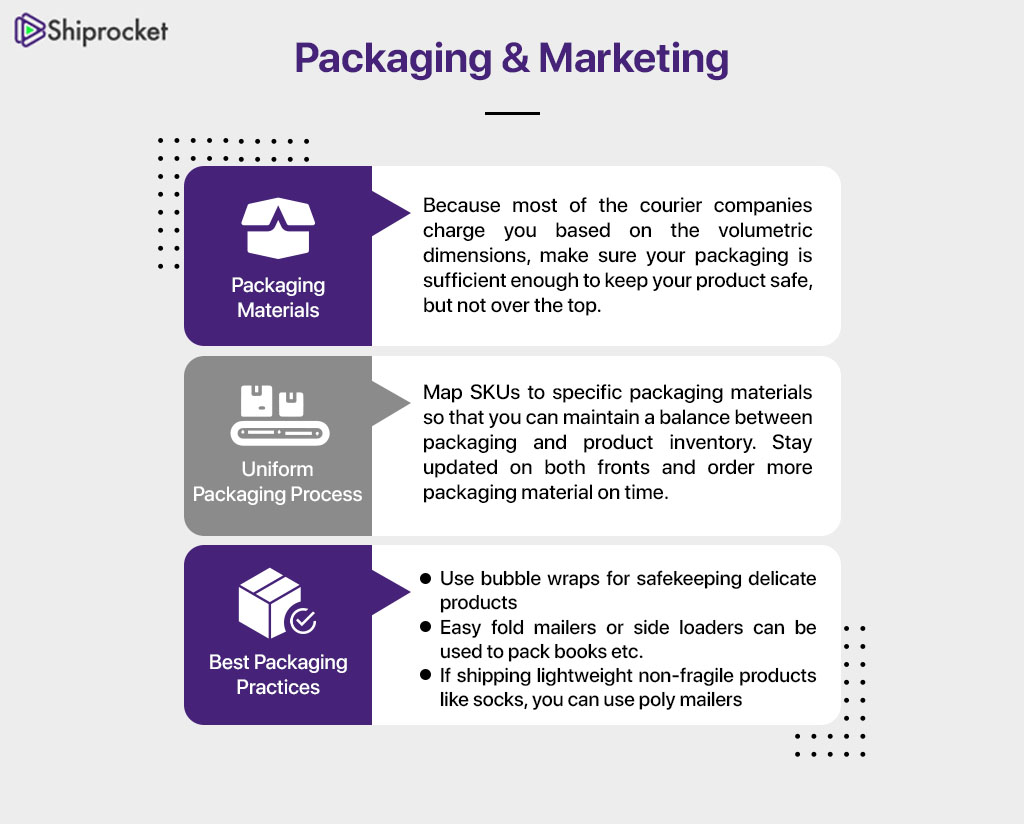
Best Packaging Practices
Here are the best packaging practices you must look out for-
- Use bubble wraps for safekeeping delicate products.
- For business products, use boxes or envelopes
- Easy fold mailers or side loaders can be used to pack books etc.
- If shipping lightweight non-fragile products like socks, you can use poly mailers.
- For branded packaging, use ribbons, personalized notes, craft papers, and more.
Further Reads: Packaging Best Practices For E-commerce Business Success
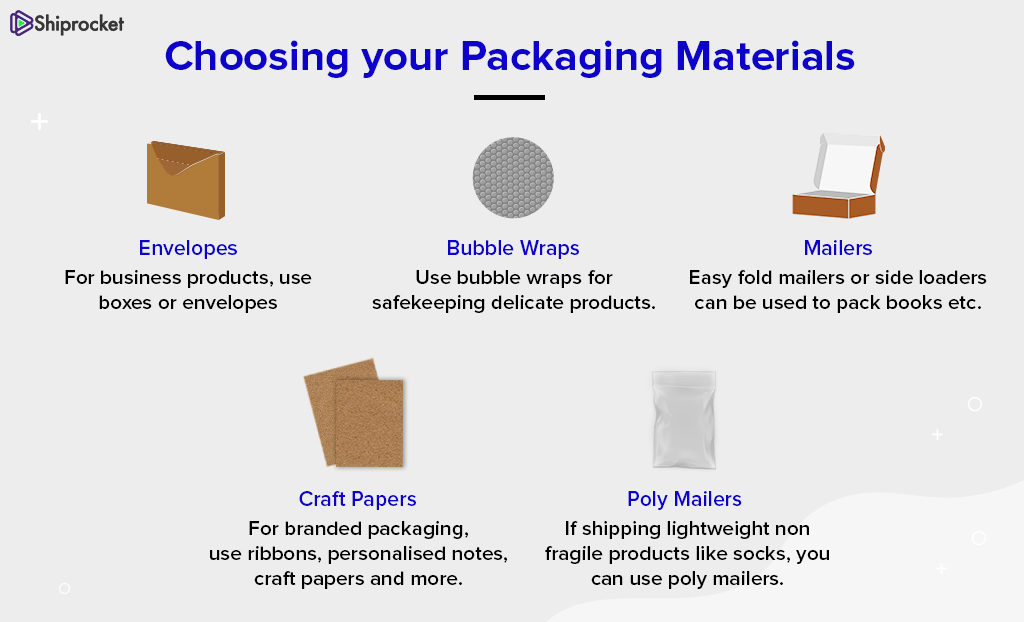
Shiprocket Packaging
Shiprocket has also launched its own packaging line where we offer the finest quality packaging material like 3 Ply corrugated boxes and flyers.
These are some of the finest quality packaging materials at the most affordable rates. You can get these delivered to your doorstep and maintain a thorough process between inventory and packaging management from one platform itself.
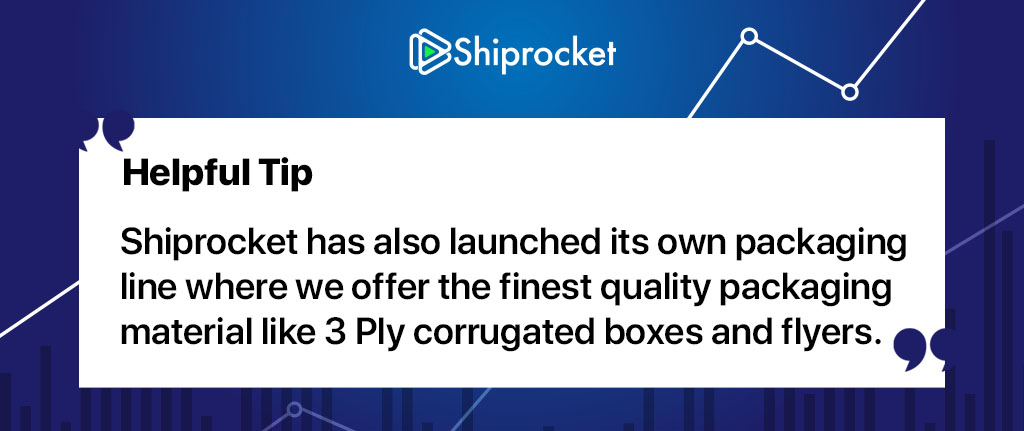
Choosing the best carriers
One of the final steps of the eCommerce shipping process, where you must pay attention is choosing the right carriers for your business. Here’s what you must consider-
Calculate shipping costs
Unless you get an estimate of your shipping costs, how will you put your best efforts in minimizing it? For this reason, consider all the important elements that are contributing to your shipping cost. These include-
- Package weight
- Size of your package
- Origin Pin Code
- Destination Pin Code
- Insurance (If you’re offering)
Once you’ve listed down all these parameters, you can enter them in a rate calculator tool to know your shipping costs.
An ideal rate calculator tool must also be able to provide you with a comparison of rates by different courier partners. It will help you in minimizing your shipping costs by handing over your parcel to the lowest cost partner.
Use the Courier recommendation Engine
Alternatively, if you have a hard time finding the right courier partner for your company, you can also use a courier recommendation engine that will find the right partner for your products. All you require to do is provide the tool with your shipping priority, whether you want to ship with the cheapest partner or the top-rated.
Calculate your margins
Pricing your product for the customer requires a number of factors to be taken into consideration. But if you need to be successful in the world of eCommerce, keeping an eye on profits must never be neglected. And shipping contributes to a significant chunk of your business costs, which is why you must always include them in your product pricing.
Tip: Represent all your costs in a tabular format when finalizing your pricing. It is because until you actually list all your costs, you may be surprised by how quickly little charges add up.
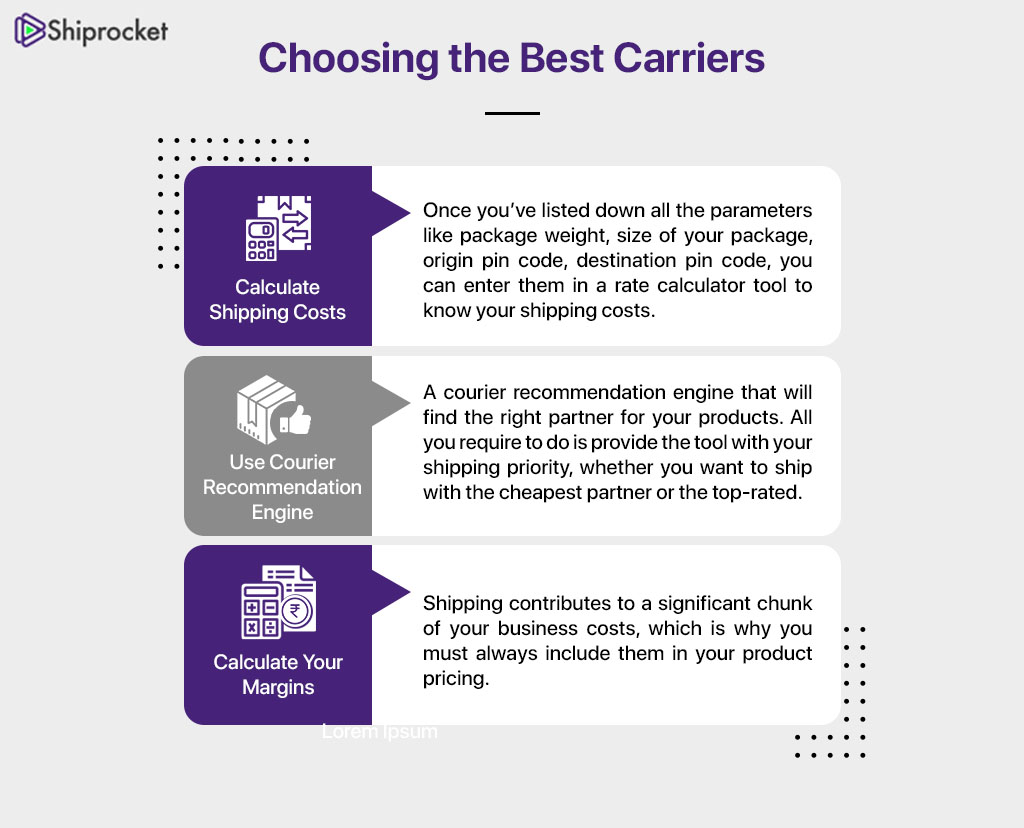
Conclusion
Shipping can undoubtedly be a challenge for eCommerce sellers. And these challenges are bound to be unique concerning the nature of your business. To overcome these, you’ll need to work hard by adopting different practices and keeping a check on what’s working for your business.
Just like many aspects of your business that take time in the building, tweaking, and working your way to customer satisfaction through shipping will require your patience but will ultimately pay off.
FAQs (Frequently Asked Questions)
The shipping rate is calculated on the basis of the weight of the product and the shipping destination.
We take either the weight of the product or the biometric weight of the product, whichever is higher.
Yes, if you have packed the product in a bigger box than required, the volumetric weight of the product will increase, leading to increased shipping rates.
You can choose between hyperlocal shipping, standard shipping, express shipping, and international shipping.

